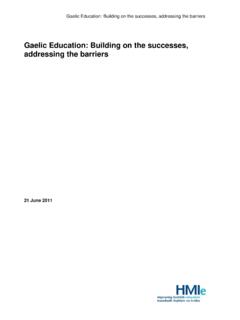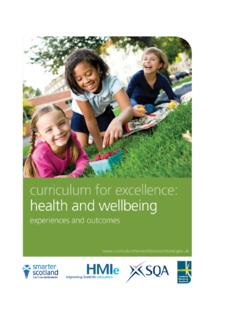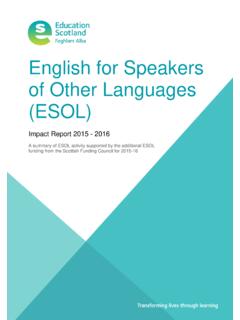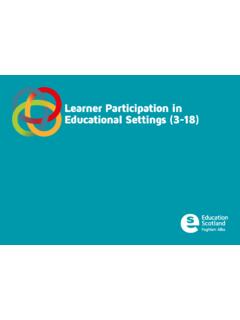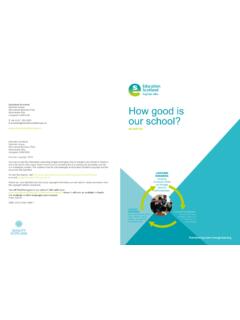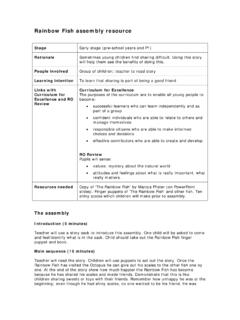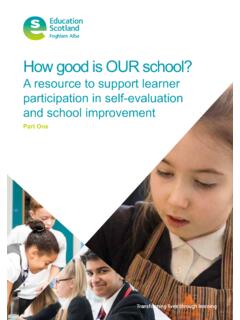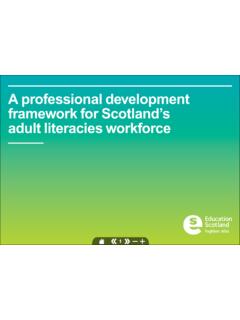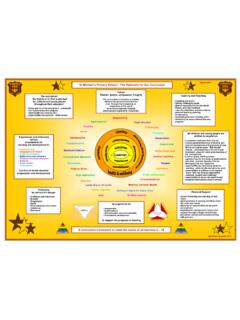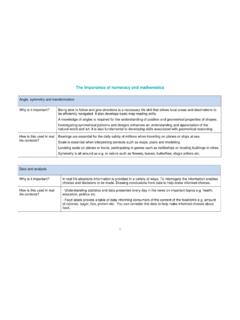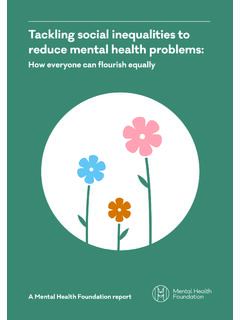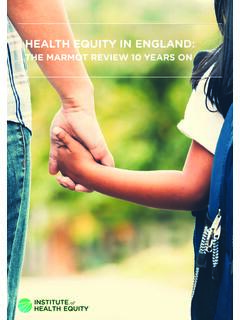Transcription of Health and Wellbeing the responsibility of all 3-18 Impact ...
1 Health and Wellbeing : the responsibility of all 3-18 September 2013 Transforming lives through learning Foreword The strong links that exist between Health and Wellbeing , on the one hand, and achievements in learning on the other, are widely recognised. Effective learning supports positive Health and Wellbeing , and good levels of Health and Wellbeing support effective learning. The Impact of this inter-dependency on long-term Health and social outcomes is most acutely played out in the crucial developmental period from early childhood through to the teenage years. That is when we can make the most positive Impact and that is why we have such a core focus on children s and young people s Health and Wellbeing in key national policies such as Getting It Right for Every Child (GIRFEC) and Curriculum for Excellence. The findings presented in this report focus on the extent to which all staff in early years centres, schools and their community partners across Scotland are working together to tackle the Health issues and inequalities that face our children, young people and their families today.
2 Although we identify a number of areas for improvement there are also many examples of highly effective practice. These examples demonstrate what is possible when everyone is clear about why Health and Wellbeing is fundamental to improving outcomes for learners and understands their role in achieving successful outcomes. From my perspective I also see this report as marking the determination of Education Scotland to work with educational practitioners and the wider Health and social justice communities in Scotland to make sure that our children and young people have the best possible chances in life, now and in the future. I hope you find this report and future related follow-up activities useful and I invite you to join with us in addressing the challenges it poses. Bill Maxwell Chief Executive Education Scotland Contents Introduction 1 Context 2 Partnership 5 Career-long Professional Learning 9 Learners Voice and Engagement 11 Leadership 15 Self-evaluation and Looking Ahead 18 Summary 22 Appendix 1 List of establishments visited 26 Appendix 2 Links to useful resources 27 Appendix 3 Links to selected suggested relevant reading 29 Appendix 4 Links to useful organisations associated with Health and Wellbeing in Scotland 30 1 Introduction This report evaluates current practice in the aspects of Health and Wellbeing that are the responsibility of all staff 1and adults who work with learners.
3 It identifies good practice and highlights important areas for further discussion and development. The report comes at a time when Scottish schools are taking forward Curriculum for Excellence and the findings reflect this changing landscape. Curriculum for Excellence provides a strong focus on Health and Wellbeing . It emphasises the need for all professionals and volunteers to work together towards the common goal of improving the Health and Wellbeing and life chances of children and young people across Scotland. It describes the importance of embedding Health and Wellbeing across learning, whether this takes place within the school or other learning environment, at home or in the wider community. This new and welcome approach offers the opportunity to transform the Health and Wellbeing of Scotland s children and young people. Education Scotland will continue to support these changes and share new and emerging good practice as part of its commitment to the national on-line professional learning community for Health and Wellbeing .
4 It is intended that this web-based report will be a stimulus for professional dialogue and debate, and that the professional learning community will be a hub for on-going discussion and development in schools and communities across Scotland. The report will be a focus for dialogue at The Scottish Learning Festival in 2013 and will set the agenda for taking forward improvements in Health and Wellbeing in the future. Practitioners will then be encouraged to engage with each other and with Education Scotland staff to further share practice and address areas requiring further development. Further links will be added to the report over time. The report is one in a series designed to gauge the Impact of a changing curriculum on learners experiences and achievements. It is important that readers consider the report s messages in line with other key national reports and documents that refer to the Health and Wellbeing of children and young people.
5 A list of key national reports and documents is included in Appendix 2. 1 Where the term staff is used this refers to all practitioners including early years workers, community learning and development workers and teachers. 2 The evidence that informed this report came from the following sources: A series of focused engagement visits within a learning community or cluster of schools in four education authorities across Scotland. Importantly, this approach enabled the team to visit a range of provision across a locality, which included early years centres, primary, secondary and special schools. This provided the team with a more coherent picture of the overall experience for the children, young people and families of these communities. A list of establishments visited for this report is included in Appendix 1. An analysis of relevant evidence from general inspections over the past three years.
6 Background reading of other relevant reports to take account of key messages pertinent to Health and Wellbeing . Engagement in professional dialogue with- practitioners and specialists across Education Scotland; Scottish Government colleagues with responsibility for Health and Wellbeing in communities; and members of the Health and Wellbeing community, both within and out-with the education sector. Context The Chief Medical Officer for Scotland makes it clear in his Annual Report of 2011, that tackling Health inequalities is a priority in improving outcomes for all in Scotland. It is also important to understand that the interactions between the Health determinants listed above, will require professionals working in What is also clear from the relentless widening of the gap between rich and poor is the fact the origins of Health inequalities are complex and that they are to be found in the many interactions between social economic, educational and environmental determinants.
7 Sir Harry Burns, Chief Medical Officer Annual Report, Health in Scotland 2011 - Transforming Scotland s Health 3 those areas to come together and develop approaches that are new, challenging, creative and sustainable. He goes on to say that the interactions between an individual and the people and events which surround him are absolutely crucial to his Health and Wellbeing . What is currently known is that individuals exposed to four or more adverse life events such as abuse and neglect in early in life, have a significantly higher risk of alcoholism, drug abuse, depression and suicide attempt in adulthood. But there is also evidence that Health inequalities can be reversed. Interventions which support and enhance early life experiences for children and their families currently offer the best possibility for change. Scottish Government has invested heavily in an attempt to address these issues through the Early Years Framework and Getting it Right for Every Child (GIRFEC).
8 These are brought together through the Early Years Collaborative (EYC) initiative, which focuses on effective joint-working between Health professionals and local authorities, including education services. This strengthened approach is already resulting in improved joint planning and service provision across Scotland. Scottish Government in Supporting Scotland s Young People s Health and Wellbeing state that: Actions across the life course to improve Health and Wellbeing contribute to delivering the Government s overall purpose of increasing sustainable economic growth. Improving Scotland s Health record is both an essential driver of growth and a key outcome of economic success. The Purpose is supported by the Strategic Objective for Health which is Helping people to improve and sustain their Health , especially in disadvantaged communities, ensuring better, local and faster access to Health care , and by 16 National Outcomes, a number of which are particularly relevant to children and young people s Health and Wellbeing : our children have the best start in life and are ready to succeed.
9 Our young people are successful learners, confident individuals, effective contributors and responsible citizens. we have improved the life chances for children, young people and families at risk. we live longer, healthier lives. we have tackled the significant inequalities in Scottish society . Scottish Government is clear that one of the main drivers for bringing about improvements in Health outcomes for children and young people is through education and the implementation of Curriculum for Excellence. The Curriculum for Excellence Health and Wellbeing Principles and Practice paper sets out the purposes of learning within Health and Wellbeing and describes how the experiences and outcomes are organised. It further provides guidance on aspects of learning and teaching, broad features of progression, assessment and connections with other curriculum areas. It outlines an ambitious agenda for all professionals as well as the entitlements of all children and young people in this area.
10 4 Curriculum for Excellence identifies the aspects of Health and Wellbeing which are the responsibility of all as: mental and emotional Wellbeing ; social Wellbeing ; physical Wellbeing ; some features of planning for choices and changes; some features of relationships; and some features of physical activity and sport. Alongside acquiring the essential skills of literacy and numeracy, the development of skills and knowledge in Health and Wellbeing sits at the very centre of all learners experiences, from age 3 to 18. Learning in Health and Wellbeing ensures that children and young people develop the knowledge, understanding and skills which they need now and importantly, in the future. The development of knowledge and skills embedded within Health and Wellbeing are central to healthy development, rewarding and fulfilling lifestyles across the life stages, and the employability prospects of learners.
